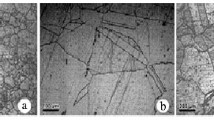Abstract
Near-threshold fatigue crack growth behavior has been investigated in niobium-hydrogen alloys. Compact tension specimens (CTS) with three hydrogen conditions are used: hydrogen-free, hydrogen in solid solution, and hydride alloy. The specimens are fatigued at a temperature of 296 K and load ratios of 0.05, 0.4, and 0.75. The results at load ratios of 0.05 and 0.4 show that the threshold stress intensity range (ΔK th ) decreases as hydrogen is added to niobium. It reaches a minimum at the critical hydrogen concentration (C cr ), where maximum embrittlement occurs. The critical hydrogen concentration is approximately equal to the solubility limit of hydrogen in niobium. As the hydrogen concentration exceeds C cr , ΔK th increases slowly as more hydrogen is added to the specimen. At load ratio 0.75, ΔK th decreases continuously as the hydrogen concentration is increased. The results provide evidence that two mechanisms are responsible for fatigue crack growth behavior in niobium-hydrogen alloys. First, embrittlement is retarded by hydride transformation-induced and plasticity-induced crack closures. Second, embrittlement is enhanced by the presence of hydrogen and hydride.
Similar content being viewed by others
Abbreviations
- C :
-
solubility limit, ppm wt
- C 0 :
-
hydrogen concentration, ppm wt
- C cr :
-
critical concentration at maximum embrittlement, ppm wt
- da/dN :
-
fatigue crack growth rate, m/cycle
- ΔK :
-
stress intensity range, MN/m3/2
- ΔK eff :
-
effective stress intensity range, MN/m3/2
- ΔK eff,th :
-
effective threshold stress intensity range, MN/m3/2
- ΔK th :
-
threshold stress intensity range, MN/m3/2
- (ΔK th )min :
-
minimum threshold stress intensity range, MN/m3/2
- R :
-
load ratio
References
I. Machlin, R.T. Begley, and E.D. Weisert: Proc. AIME Symp. on Refractory Metal Alloys, Metallurgy and Technology, Plenum Press, New York, NY, 1968, p. 197.
M.M. Farahani, F. Attia, and K. Salama: Metall. Trans. A, 1981, vol. 12A, pp. 631–38.
S. Gahr, M.L. Grossbeck, and H.K. Birnbaum: Acta Metall., 1977, vol. 25, pp. 125–34.
D.G. Westlake and S.T. Ockers: Metall. Trans. A, 1975, vol. 6A, pp. 399–402.
L.W. Berger, W.S. Hyler, and R.I. Jaffee: Trans. TMS-AIME, 1958, vol. 212, pp. 41–45.
D.W. Chung and N.S. Stoloff: Metall. Trans. A, 1978, vol. 9A, pp. 71–78.
C.V. Owen, W.A. Spitzig, and O. Buck: Metall. Trans. A, 1987, vol. 18A, pp. 1593–1601.
E. Elber: Eng. Fract. Mech., 1970, vol. 2, pp. 37–45.
R.O. Ritchie: Proc. 2nd Int. Conf. on Fatigue and Fatigue Thresholds, C.J. Beevers, ed., Engineering Materials Advisory Services, West Midlands, England, 1984, pp. 1833–63.
D. Tayor: Int. J. Fatigue, 1988, vol. 10, pp. 67–79.
H. Kobayashi: Proc. 6th Int. Conf. on Fracture, S.R. Valluri, D.M.R. Taplin, P. Rama Rao, and J.F. Knott, eds., Pergamon Press, Oxford, England, 1984, pp. 2481–88.
T.T. Shih and R.P. Wei: Eng. Fract. Mech., 1974, vol. 6, pp. 19–32.
R.D. Pendse and R.O. Ritchie: Metall. Trans. A, 1985, vol. 16A, pp. 1491–1501.
J.A. Todd, P. Li, G. Liu, and V. Ramam: Scrip. Metal., 1988, vol. 22, pp. 745–50.
R.L. Eadie and F. Ellyin: Scrip. Metal., 1989, vol. 23, pp. 585–92.
E. Smith: Int. J. Pressure Vessels Piping, 1994, vol. 60, pp. 159–65.
E. Smith: Int. J. Pressure Vessels Piping, 1994, vol. 61, pp. 1–7.
J.B. Bai, C. Prioul, and D. Francois: Metall. Mater. Trans. A, 1994, vol. 25A, pp. 1185–97.
F.H. Horn and W.T. Ziegler: J. Amer. Chem. Soc., 1947, vol. 69, pp. 2762–69.
D.G. Westlake: Trans. TMS-AIME, 1969, vol. 245, pp. 287–92.
Elemental and Interplanar Spacing Index for Phase Identification by Electron or X-ray Diffraction, U.S. Department of Commerce, NIST, and JCPDS, Swarthmore, PA, 1989, p. 674.
R. Bazil, G.W. Simmons, and R.P. Wei: J. Eng. Mater. Technol., 1979, vol. 101, pp. 199–204.
M. Kikukawa, M. Jono, and K. Tanaka: Proc. 2nd Int. Conf. on the Mechanical Behavior of Materials, N. Promisel and V. Weiss, eds., ASM, Metals Park, OH, 1976, pp. 716–20.
D.S. Shih, I.M. Robertson, and H.K. Birnbaum: Acta Metall., 1988, vol. 36, pp. 111–24.
J.K. Tien, A.W. Thompson, and R.J. Richards: Metall. Trans. A, 1976, vol. 7A, pp. 821–29.
H.K. Birnbaum, M. Grossbeck, and S. Gahr: Proc. 1st Int. Conf. on the Effects of Hydrogen on Materials Properties and Selection and Structural Design, I.M. Bernstein and A.W. Thompson, eds., ASM, Metals Park, OH, 1973, pp. 303–23.
S. Gahr, B.J. Makenas, and H.K. Birnbaum: Acta Metall., 1980, vol. 28, pp. 1207–13.
L.A. Simpson and M.P. Puls: Metall. Trans. A, 1979, vol. 10A, pp. 1093–1105.
C. Weatherly: Acta Metall., 1981, vol. 29, pp. 501–12.
M.P. Puls: Metall. Trans. A, 1988, vol. 19A, pp. 1507–22.
M.P. Puls, L.A. Simpson, and R. Dutton: Fracture Problems and Solutions in the Energy Industry, L.A. Simpson, ed., Pergamon Press, Oxford, England, 1982, pp. 13–25.
T. Schober and H. Wenzl: in Hydrogen in Metal II, G. Alefeld and J. Volkl, eds., Springer-Verlag, New York, NY, 1978, pp. 11–71.
B.J. Makenas and H.K. Birnbaum: Acta Metall., 1980, vol. 28, pp. 979–88.
R.M. MeMeeking and A.G. Evans: J. Amer. Ceram. Soc., 1982, vol. 65, pp. 242–46.
J.C. Newmann: ASTM STP 748, ASTM, Philadelphia, PA, 1976, pp. 53–84.
B. Budiansky and J.W. Hutchinson: J. Appl. Mech., 1978, vol. 45, pp. 267–76.
T.C. Lindley and C.E. Richards: Mater. Sci. E., 1974, vol. 14, pp. 281–93.
M.B. Cortie and G.G. Garrett: Metall. Trans. A, 1988, vol. 19A, pp. 2979–87.
Author information
Authors and Affiliations
Rights and permissions
About this article
Cite this article
Lin, M.CC., Salama, K. Fatigue crack growth behavior in niobium-hydrogen alloys. Metall Mater Trans A 28, 2059–2065 (1997). https://doi.org/10.1007/s11661-997-0162-y
Received:
Issue Date:
DOI: https://doi.org/10.1007/s11661-997-0162-y




